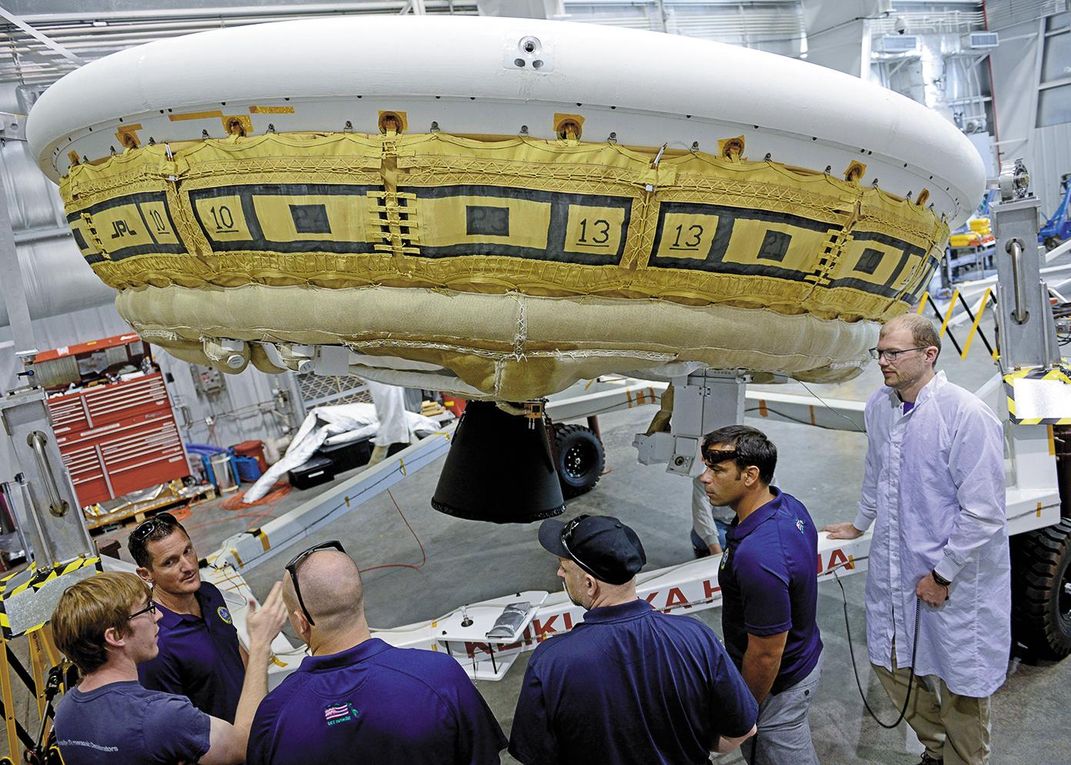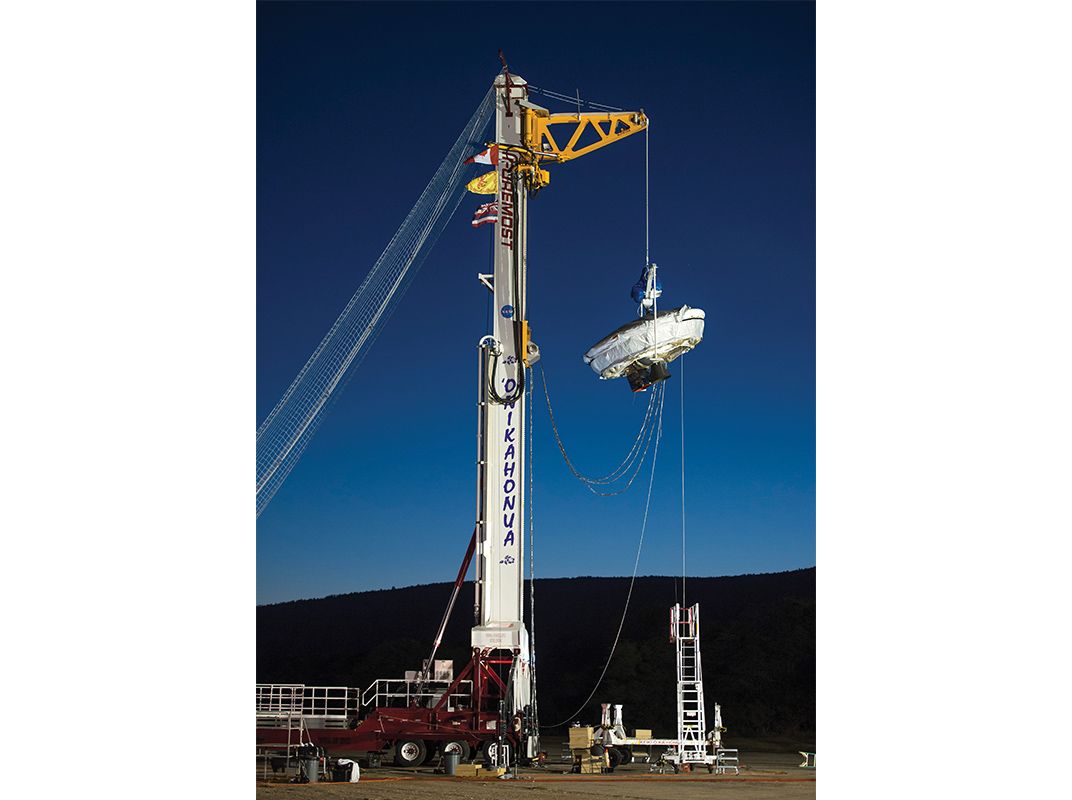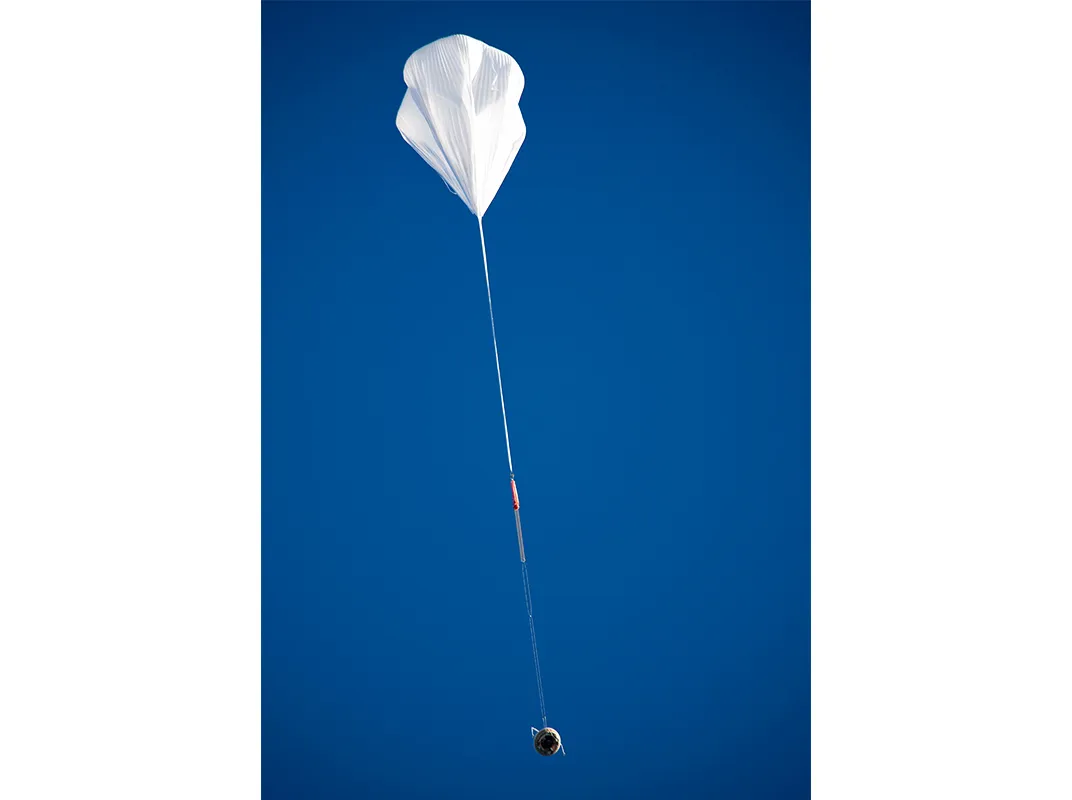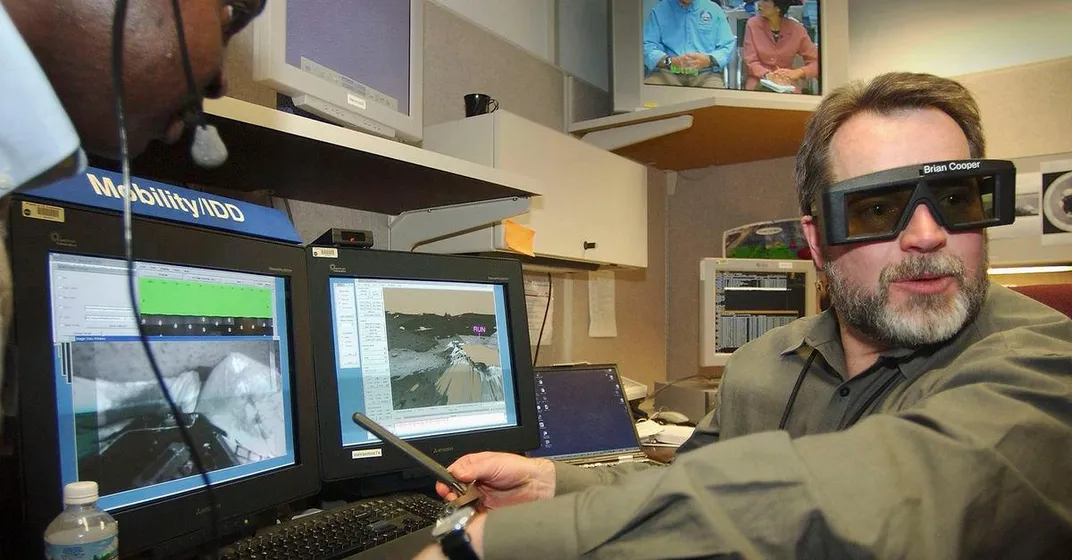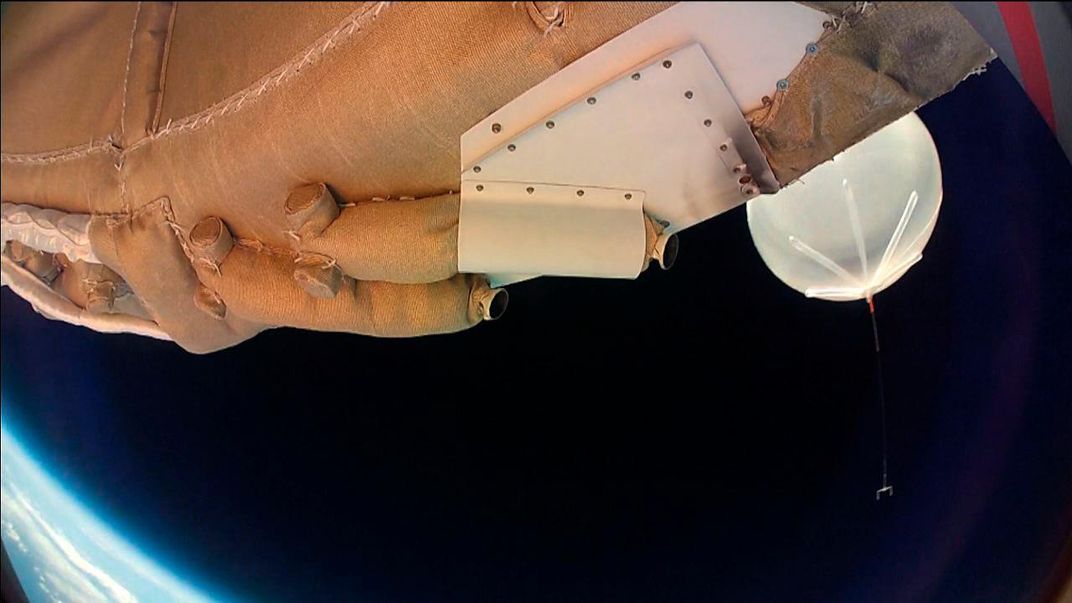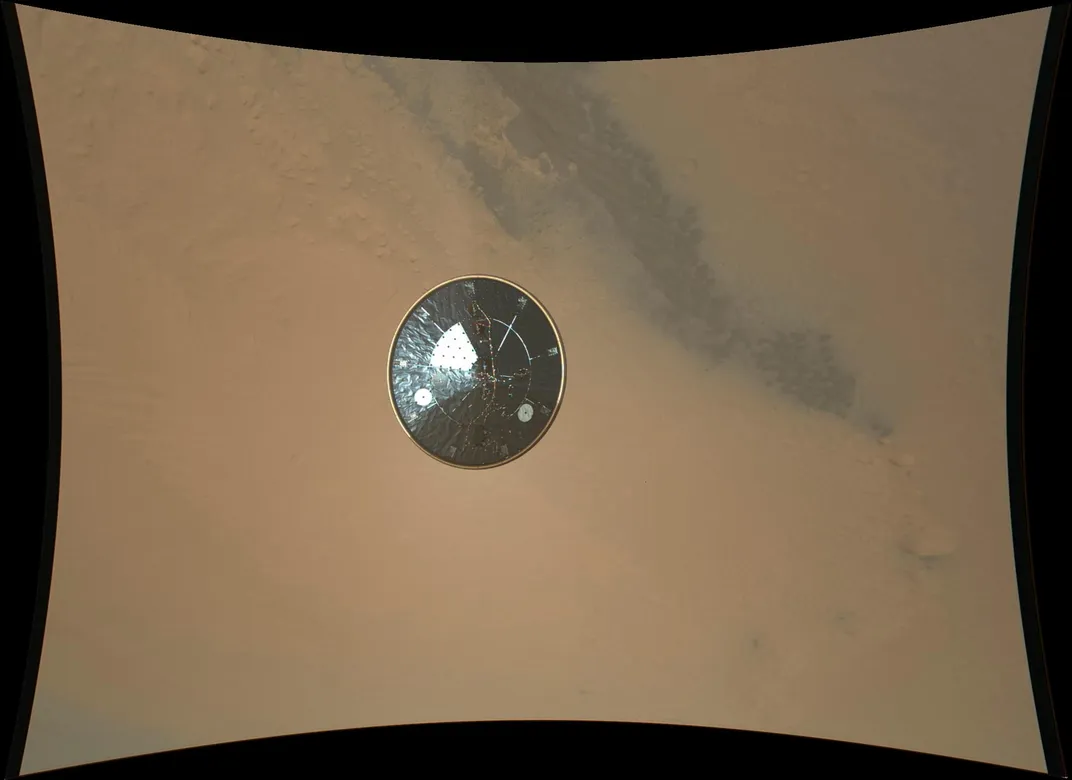How to Land a House on Mars
NASA thought it knew, until an alarming failure last summer.
:focal(1280x1190:1281x1191)/https://tf-cmsv2-smithsonianmag-media.s3.amazonaws.com/filer/24/f1/24f11c8b-7bf3-4e0a-bc77-20f5f3e29d1e/06v_fm2016_ypreviousmissionparachutemarsscienceb_live.jpg)
A notebook owned by Leonardo da Vinci more than 500 years ago contained his concept for a parachute. His design used cloth stretched over a rigid, pyramid-shaped frame to create drag. He never tested it, but others did, much later, and it basically worked. It wasn’t exactly like the parachutes that would be perfected in the four centuries after his death, but the principle on which it operated—harnessing atmospheric friction to create drag and resist freefall—was the same.
That principle may work on da Vinci’s planet, with its thick, protective atmosphere. But what if you’re trying to drop something to the ground elsewhere in the solar system, like Mars? Creating enough drag to decelerate a spacecraft to a safe touchdown speed in that planet’s thin, shallow atmosphere is about as easy as trying to sew yourself a parachute after you’ve already jumped.
This is the problem that plagues Rob Manning, a flight systems engineer who’s been around NASA’s Jet Propulsion Laboratory long enough to see two decades of Mars missions firsthand (“The Mars Dilemma,” Oct./Nov. 2014). Now he’s on the team trying to figure out how to get the next generation of landers—the precursors to human missions—safely to the surface.
**********
In the months after the Mars Science Laboratory rover, Curiosity, made its impressive landing in August 2012, Manning, the mission’s chief engineer, gave some talks about the development of the rover’s descent maneuver. He wanted to include lessons learned from the first spacecraft to land on Mars. Viking 1 and Viking 2 touched down in June and August of 1976, respectively, using massive parachutes to slow their descents before retro-engines fired to bring the spacecraft down in a powered, soft landing.
In 1972, engineers prepared for these inaugural Martian touchdowns with four tests of the descent system on Earth. Manning started searching the Internet for photos from these high-altitude, supersonic parachute trials, and stumbled upon images of 16-millimeter film cans on an auction website that trades in rare space memorabilia. He was stunned. More than a decade earlier, while working on Mars Pathfinder (which deposited the Sojourner rover in 1997), Manning and his colleagues had searched the records of these parachute trials from 25 years earlier—the first three tests suffered failure or damage of some kind; only the fourth succeeded at speeds well above Mach 2. And the researchers could not find the film of that crucial fourth test. One set of films, held by Lockheed Martin in Denver, Colorado, had been destroyed by water damage; the set at NASA’s Langley Research Center in Virginia was lost in an office move. There were reams of reports on those tests. The National Archives had some footage of the second trial. But what the team really wanted—film of the successful supersonic inflation of the parachute—could not be found. Manning contacted the auction site, but the proprietor told him the footage had been sold, and he could provide no information about the buyer.
These days, Manning isn’t trying to slow the descent of just an oversize rover; he’s working on landing technology for the kind of massive spacecraft that would bring supplies and habitats for the first human missions. These spacecraft are going to need bigger, stronger parachutes than anyone has made before. And they have to be tested at more than double the speed of sound, 34 miles up, where Earth’s atmosphere becomes thin enough to serve as a passable Mars analog.
No one had done any parachute tests like this since Viking, 40 years ago, and it’s easy to understand why: Descent tests in the atmosphere are maddeningly difficult and eye-wateringly expensive. And they were, for a long time, unnecessary. In the decades since Viking, NASA has put five more landers—Sojourner, Spirit, Opportunity, Phoenix, and Curiosity—on Mars using parachutes developed through subsonic trials in wind tunnels. (NASA’s Mars Polar Lander was lost during its descent in 1999, but the postmortem found the likely culprit to be an engine’s premature cut-off.) But the 70-foot-wide parachute NASA had perfected using the wind tunnel data had reached a limit: It could safely land no more massive an object that the one-ton Curiosity it helped reach Mars in 2012.
In the next decade, NASA is sending two more missions to Mars—InSight, presently due to launch in 2018 (its March launch was just canceled), and the Mars 2020 rover—both of which are light enough to use descent systems that have already been developed. Mars 2020, essentially a copy of Curiosity with a different scientific payload, will land using the same multi-stage method its predecessor did: A capsule containing the rover will first use its heat shield to enter the Mars atmosphere, slowing from 13,000 mph to about 1,000 mph; then the supersonic parachute will deploy, causing a sudden deceleration of around nine Gs and arresting the capsule’s speed to near 200 mph. Finally, the heat shield will pop off and a rocket-powered skycrane will separate from the capsule and parachute, lowering the rover the final few dozen yards to the ground.
The Mars atmosphere varies in density with the season, and since it will be thicker during 2020’s descent, the spacecraft can be several hundred pounds heavier than Curiosity and use the same parachute. But the 2020 rover is still far lighter than the lander that would be needed for a more substantial robotic explorer, one that could perform a sample-return mission—or one day, for the lander that would carry the vehicles, supplies, and equipment that will be sent ahead to await the arrival of humans on Mars.
NASA’s going to need a bigger parachute.
**********
Last June, a new, 100-foot-diameter parachute that Manning and his colleague Ian Clark had every reason to believe would work underwent a second test—a deployment that ended in a confidence-bruising failure. The system is called the Low-Density Supersonic Decelerator, or LDSD, a two-stage Mars-landing solution that has been in the testing phase since 2012. One of the stages, the one that isn’t a parachute, has been performing flawlessly. They’re still working on the other one.
Baffled by the failures, Manning set off again with a renewed urgency to find that old Viking-era test film. This time, he found it. It turned out the man who won the film at the auction had donated it to the South Florida Museum in Bradenton, home to a state-of-the-art planetarium (and a rehabilitation aquarium starring Snooty, “the oldest known manatee in the world”). When Manning called the museum to explain why he wanted the footage, the staff was happy to hand it over.
Manning and Clark hope their analysis of the old film—now being restored and converted to digital files at a Hollywood film restoration outfit—may help them understand why two different designs for their massive parachute, a key piece in NASA’s plans to one day colonize Mars, have shredded to ribbons during supersonic flight tests.
**********
The first stage of the LDSD system is called the Supersonic Inflatable Aerodynamic Decelerator, a pressure vessel made out of Kevlar that inflates around the descending spacecraft like a tire around a wheel, slowing it to around Mach 2. We’ll call this the Doughnut. Doughnuts are being built in two diameters: The 20-foot R-model is intended for robotic deployments, while the 26-foot E-model (for Exploration) will service “human-precursor-class missions,” according to Clark.
The second stage is the parachute. When it deploys it must slow the spacecraft from Mach 2 to subsonic speeds. (Eventually, a final stage, such as Curiosity’s skycrane or Vikings’ retro-firing engines, will complete the maneuver and get the spacecraft all the way to the surface.)
The first atmospheric flight test of the system was conducted near Kauai, Hawaii, at the U.S. Navy’s Pacific Missile Range Facility in June 2014; the second was held a year later. Because of the weather conditions in this part of the upper atmosphere over the ocean, the window for these tests is only about three weeks, always in June.
First, a balloon carries the 15-foot-wide, 6,800-pound saucer-like test vehicle—a stand-in for future real landers—to 120,000 feet. The balloon is released as the saucer fires its rocket engine, accelerating to Mach 4, climbing into the thin air at 180,000 feet, and changing its angle of attack so that its travel is parallel to the ground. Then the deceleration test begins: The rocket stops thrusting and the Doughnut inflates around the saucer. (That’s the smaller R-model; the larger version hasn’t flown yet.) The inflation slows the package to roughly Mach 2.4, at which point a mechanism deploys a ballute—a balloon-parachute hybrid—which inflates, then pulls the parachute out the back of the test vehicle. The parachute, in theory, should inflate and slow the saucer’s travel into a vertical descent and a spacecraft-survivable ocean impact.
In both flight tests, the Doughnut has performed perfectly, slowing the spacecraft to its target speed. So has the ballute—that performance was a pleasant surprise. Past Mars landers have used a mortar-like device, “a giant cannon that shoots a tightly compressed parachute pack behind the vehicle,” Clark explains. But that technology wouldn’t work aboard this flying saucer. With its solid rocket motor occupying the center, a mortar would have to be mounted to one side. Firing the mortar from off-center would throw the spacecraft into a tumble.
Extrapolating from research conducted by the U.S. Air Force and NASA in the 1960s, the team designed the ballute and quickly built it; there was no time for testing before it joined the LDSD system for a ride to the mesosphere. For a week prior to the first supersonic test, conducted in Hawaii, Clark had nightmares about watching from the control room as the ballute failed to inflate, leaving the parachute packed—as dense as a block of wood, and about as useful. “But it was an incredibly successful device,” Clark says. He had no nightmares about the parachute…which almost instantly tore apart.
“The inflation process is more complicated than we thought it was,” Manning explains. “All of us believed until very recently that the maximum stress on the parachute occurs when it’s at its largest size…. What we learned last summer is, we’re wrong. It turns out the fabric gets pulled on by itself, without even the suspension lines pulling very hard on the parachute. It can be torn apart by the incredible speed of inflation.”
Despite the failure of the parachute, the test produced “imagery of a quality we’d never had before, visualizing the inflation of a supersonic parachute,” says Clarke. “We’ve been using these devices at Mars for 40 years, but we never had a data set like what we got out of that first supersonic flight. We started seeing things we had never seen before—how chaotic that inflation can be.”
**********
With a diameter 50 percent bigger than the parachute used for Curiosity, the LDSD parachute is too big to test in the wind tunnel used in designing the parachutes for all of the post-Viking Mars landers. So the team has conducted ground tests at Naval Air Weapons Station China Lake in California’s Mojave Desert. The facility has a 4.2-mile-long railroad with rocket-powered steel sleds that slam into blocks of concrete, decommissioned aircraft, or whatever else is on the receiving end of the impact situation being studied. For the LDSD project, the rocket sleds are used to tow an object to high speed without the risk and expense involved in being airborne.
Before the 2014 flight test, the descent team put the Doughnut on a subsonic rocket-sled ride, and when that went well, they decided it was ready for its supersonic debut. They tried to test the parachute too, but high winds scuttled that test.
After the first failure, and two months before the second supersonic flight test, the team went back to China Lake. They fortified the chute with additional Kevlar and nylon, and made a few design changes that would make it more stable and easier to control. They also built a spare, and tested both on the subsonic rocket sled. Both passed with flying colors. That gave the team a high level of confidence.
The second Hawaii flight test was more successful than the first: The parachute waited a full 0.6 second after deployment before rupturing. “It got fully inflated, then it chose to destroy itself,” says Manning. Inexplicably, the parachute began to tear at about 80,000 pounds of drag, even though the rocket sled trials indicated it should have been able to handle at least 120,000 pounds. The tests now called into question NASA’s long-held belief that subsonic testing—inflating parachutes relatively slowly before testing drag loads on the chute—was good enough to ensure parachutes would work at Mars.
“That was the process we’ve been using for years, and that process has failed us now twice in a row,” Manning says. “We’ve been scratching our heads.” After the second flight test and the stabilizing redesign, the chute’s failure has opened the door to a flood of uncertainty. “Our parachutes may not be as good as we thought they were,” Manning says. “And yet we’ve been flying to Mars all these years, and they’ve worked every time.”
Manning believes that both failures were due to the rapid speed of inflation. The problem in troubleshooting the issue is that there are few parallels between inflating a parachute supersonically in a low-atmosphere environment and inflating it subsonically in the thicker air at ground level. Supersonic inflation confounds much of what humankind has learned about parachute behavior since da Vinci.
Computer testing hasn’t worked because the data is exceedingly complex. Some engineers are trying, though; a simulation using Fluid Structure Interaction is in development, but it’s years away from being useful, says Mark Adler, the descent team’s project manager. “What makes it more complicated is that the flow field itself then gets influenced by the parachute,” he says. “So you have to update the flow field and update the parachute at each time step, which is extremely complicated. We don’t have the ability to do that today, using our most powerful computers with our best codes.”
**********
Before the LDSD team goes back to Hawaii for a third supersonic high-altitude test, the members will conduct a campaign of smaller trials to try to more accurately predict supersonic parachute behavior. They plan to send up two-stage sounding rockets from NASA’s Wallops Flight Facility in Virginia and then try to slow them down at supersonic speeds. The rockets will carry 3D cameras that should enable the engineers to reconstruct the parachute’s exact shape as it inflates so they can better understand exactly when and how the fabric gets stressed, as measured in milliseconds.
Because the sounding rockets are lighter than the flying saucer used over the Pacific, the parachutes will have to be smaller. A 100-foot chute would likely bring the rocket to a dead stop before the canopy could fully inflate, Manning says. So they’ll probably use Curiosity-grade parachutes that span 53 feet in diameter—the first tests of chutes that size in supersonic flight since Viking.
In wind tunnels and on sounding rockets, Adler says, “we’re going to subject those parachutes to loads sufficient to break them. We want to see where they break and where they don’t break. We’ll have flights where they work and flights where they don’t; wind tunnel tests where we break them and wind tunnel tests where we don’t. If we can bracket it enough, we can figure out where the threshold is for failure.” The team is shooting for six sounding rocket flights and six wind tunnel tests before going back to Hawaii.
The goal, Adler says, is “to build some understanding of how to correlate the subsonic testing to the supersonic testing. The reason that’s important to us is because subsonic testing is much, much cheaper.” He points out that Pathfinder, the Mars Exploration Rovers, and Curiosity all had unexpected parachute failures in their development; all eventually worked at Mars. “On the other hand,” he adds, “those missions all flew their parachutes at around half the flight-limit load, so they never really stressed their parachutes at Mars. There was a lot of hidden margin…. It’s possible that hidden margin saved us.”
Manning doesn’t like not knowing why those subsonically tested chutes all succeeded on Mars. “Maybe we’re closer to the edge than we thought with all our parachutes,” he says. “We just don’t know.”
Adler says that the InSight and Mars 2020 teams, which work in the same JPL building as the LDSD staffers, are watching their work closely. He’d like the 2020 team to do him a favor: “I’ve asked them for a camera” to record the parachute during its actual descent on Mars. Between all the footage taken during the Viking trials, today’s LDSD tests, and the real deal on Mars later this decade, the team will have half a century of observing parachute behavior—maybe enough for a proper movie marathon to one day entertain the Martian astronauts living in houses brought oh so gently to the surface.

